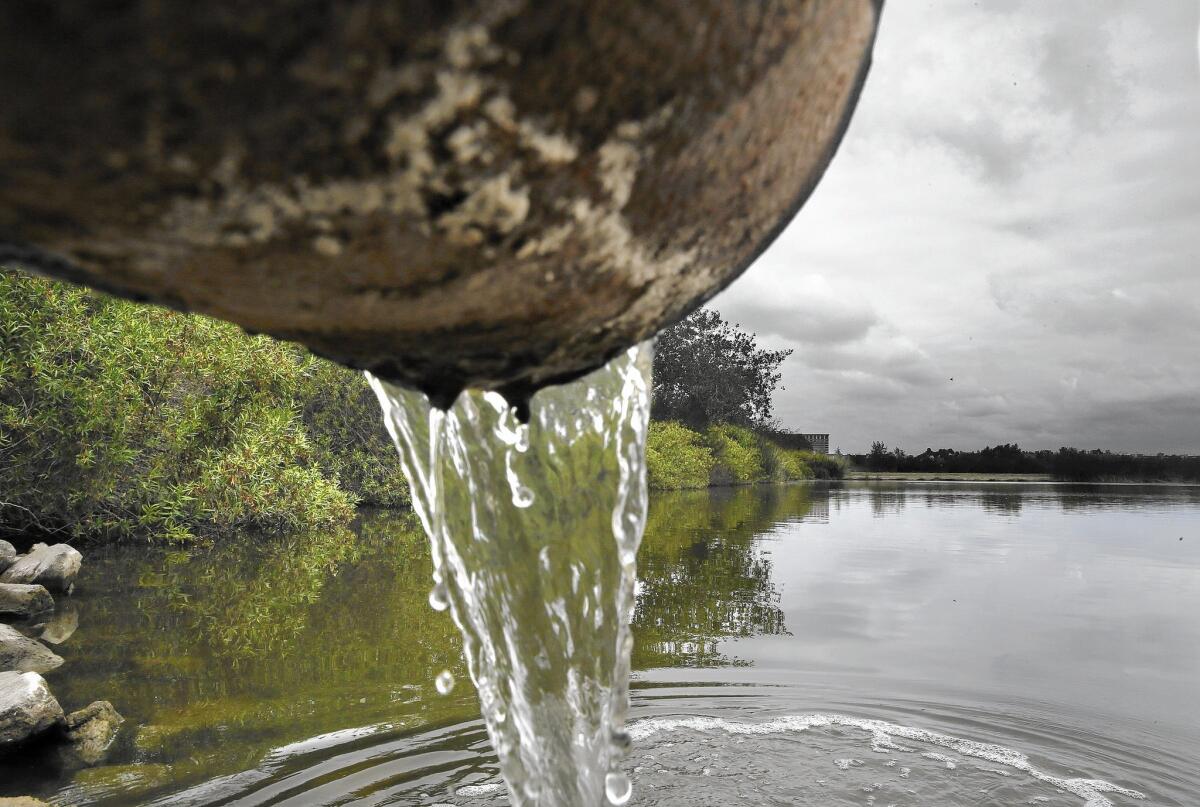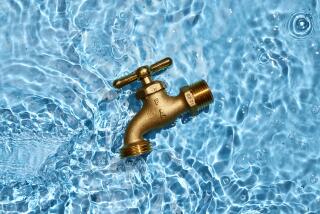Metropolitan Water District aims to build plant to recycle sewage into drinking water

For more than 80 years, the Metropolitan Water District has paved the way for Southern California’s epic growth by securing water from hundreds of miles away.
This week, the mammoth agency said it wants to invest closer to home in what would be one of the world’s largest plants to recycle sewage into drinking water.
The plan would thrust Los Angeles County to the forefront of a small but growing number of areas embracing “toilet to tap” technology to meet the water needs of their residents. It comes after four years of drought that have sparked questions about the long-term reliability of some water supplies.
For the MWD, its expanded involvement in water recycling is also a powerful statement that Southern California cannot count on imported water alone to serve a growing population.
“This is the new reality of water in California,” said Mark Gold, associate vice chancellor for environment and sustainability at UCLA. “If anything, this drought has demonstrated that you’d better have a diversified water portfolio or you’re not going to survive very well.”
Now, 58% of L.A. County’s water is imported, while 38% comes from groundwater sources, according to a UCLA study. Only 4% comes from recycling, and high processing costs have until recently limited its appeal to water providers.
The agency would partner with Los Angeles County sanitation districts to create the facility.
In a committee meeting Monday, MWD staff presented the framework of a plan to purify and reuse as much as 168,000 acre-feet of water a year — enough to serve about twice that number of households for a year.
Doing so would require the MWD to build a treatment plant and delivery facilities and comply with environmental regulations — a process that could take more than a decade.
Officials did not specify a projected cost, but similar endeavors elsewhere have required about $1 billion. They want the board to authorize a $15-million “demonstration project” in Carson as early as November. Funding could come from water revenue, state loans and grants, and possibly from a water bond passed by voters last year.
Treated and purified sewage water can cost as much as $900 an acre-foot to produce and distribute, compared with $1,400 for imported water.
Robert Ferrante, assistant chief engineer at the Sanitation Districts of Los Angeles County, said the proposal would go before his executive board next month.
But critics of the plan said Tuesday that the details are too fuzzy to move forward so fast, and that delving into recycled water production may not be MWD’s place.
“We have no clear-cut information yet about whether the program makes economic sense,” said Keith Lewinger, an MWD board member representing the San Diego County Water Authority. “We are not sure why Metropolitan wants to be involved. That’s not the business model we’ve had.”
Coastal communities in California flush hundreds of billions of gallons of treated sewage into the Pacific Ocean each year. In the last couple of decades, however, water managers have attempted to recycle some of this water for human use.
So-called purple pipe systems take sewage that has been filtered and cleansed and use it to irrigate crops, parks and golf courses — but not as drinking water.
Potable reuse systems, on the other hand, use a variety of methods to purify water that has already been processed at a sewage treatment facility. The end result of this toilet to tap process is a liquid that is cleaner than most bottled waters and intended for human consumption.
As drought places an increasing strain on traditional sources of drinking water, water managers have looked to expand water recycling systems and thereby increase local water supply. (Recycled water has been used to replenish Los Angeles County aquifers for years, but on a smaller scale.)
Los Angeles Mayor Eric Garcetti has directed the Department of Water and Power to reduce by half its purchase of imported drinking water by 2024. He has also called for an “integrated water strategy that increases local water supplies and that improves water security.”
Officials in Orange County say their Groundwater Replenishment System — which can treat as much as 100 million gallons a day — will eventually be able to purify 130 million gallons a day for reuse. They say it is the largest such system in the world.
MWD officials hope that in about a decade, their proposed treatment plant would produce 150 million gallons a day.
In recent years, the MWD has paid a subsidy to water providers that clean or recycle some of their local supply.
“Met has always been very supportive of water recycling,” MWD Assistant General Manager Debra Man said in an interview. “This takes it to the next level.”
The MWD and a partnership of two dozen county wastewater agencies — known as Sanitation Districts of Los Angeles County — have been working together on feasibility reports and pilot studies since 2010, according to documents outlining the proposed recycling project.
Ferrante, the sanitation districts engineer, said that roughly 40% of the sanitation agency’s treated sewage is recycled in one way or another. Increasing that percentage has proven difficult however.
“This is a great new source of water for Southern California,” Ferrante said. “But you can’t put all your eggs in one basket. There’s no one answer to sustainability. It’s not just desalination, it’s not just conservation, it’s not just recycling and it’s not just turf removal. It’s a combination of all those things.”
Officials said they could launch the demonstration at the sanitation districts’ Joint Water Pollution Control Plant in Carson about 20 months after the project is approved. The treatment processes would be perfected on 1 million gallons of water a day while officials conduct additional studies and develop a financing plan, according to an MWD memo.
Experts have raised concerns about waters of varying chemistries mixing in aquifers.
A study published in the journal Environmental Science & Technology found that when highly purified wastewater was stored in an Orange County aquifer, the water caused arsenic to escape from clay sediments in a way that water filtered in naturally did not.
The solution, according to Stanford University researchers, was to add calcium to the purified water before adding it to the aquifer.
Gold said there will be “enormous obstacles” ahead, such as figuring out where to store all the groundwater, who has rights to which aquifers and garnering political support for the project across the MWD board.
“But this is so sorely needed,” he said, “we have to figure out how to make it work.”
Twitter: @bymattstevens
Twitter: @montemorin








